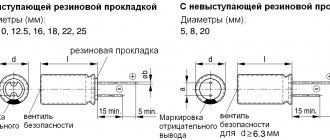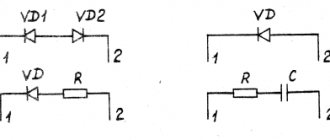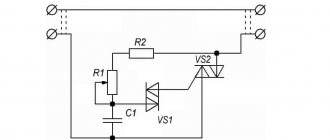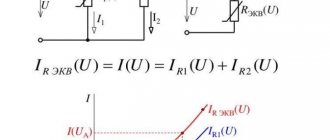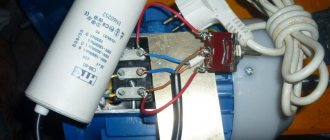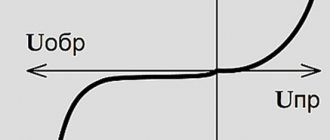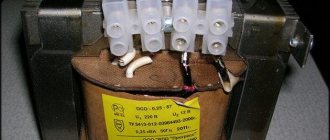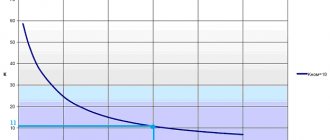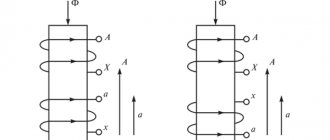This term has other meanings, see Diode (meanings).
several vacuum rectifier valves (WI1 5/20, PY88, EY51)
Vacuum diode
— vacuum two-electrode electron tube. The diode cathode is heated to temperatures at which thermionic emission occurs. When a voltage negative relative to the cathode is applied to the anode, all electrons emitted by the cathode return to the cathode; when a positive voltage is applied to the anode, some of the emitted electrons rush to the anode, forming its current. Thus, the diode rectifies the voltage applied to it. This property of the diode is used to rectify alternating current and detect high frequency signals. The practical frequency range of a traditional vacuum diode is limited to frequencies up to 500 MHz. Disk diodes integrated into waveguides are capable of detecting frequencies up to 10 GHz[1].
Device[ | ]
Designation on the diagrams of a diode with an indirectly heated cathode.
An electric vacuum diode is a vessel (balloon) in which a high vacuum is created. The cylinder contains two electrodes - a cathode and an anode. A directly heated cathode is a straight or W-shaped filament heated by a filament current. An indirectly heated cathode is a long cylinder or box, inside of which an electrically insulated heater coil is laid. Typically, the cathode is embedded inside a cylindrical or box-shaped anode, which in power diodes may have fins or “wings” to dissipate heat. The terminals of the cathode, anode and heater (in indirect incandescent lamps) are connected to external terminals (lamp legs).
Main characteristics of a vacuum diode
A vacuum diode can be characterized by the following parameters:
- The steepness of the current-voltage characteristic;
- Differential resistance;
- Maximum permissible reverse voltage;
- Blocking voltage;
- Maximum permissible power dissipation;
Calculation of transconductance and internal resistance is carried out through the anode voltage and the temperature level at the cathode.
Electric current in various environments
What conductivity do metals have? What explains this?
Metals have good electrical conductivity, which is explained by the presence of free electrons in them, which, under the influence of even a small potential difference, acquire directional movement from the negative pole to the positive one.
Dependence of the resistance of metal conductors on temperature.
As the temperature increases, the resistance of the metal conductor increases. R=R* (1 + α*∆T), where R is the resistance at 0 0 C. α is the temperature coefficient of resistance α>0. ∆Т-t.
Superconductivity.
the property of some materials to have strictly zero electrical resistance when they reach a critical temperature.
Property of a superconductor.
1) Resistance = 0, which means no heat is released; 2) The magnetic field does not penetrate the conductor, the superconductor is repelled from any pole of the magnet.
What is a vacuum?
This is a degree of rarefaction of a gas at which there are practically no collisions of molecules.
When does vacuum occur?
When the length of the free space of particles in a vessel is greater than the dimensions in the vessel.
The concept of thermionic emission.
This is the emission of electrons by solid or liquid bodies when they are heated to temperatures corresponding to the visible glow of hot metal.
Operating principle[ | ]
When the cathode heats up, electrons will begin to leave its surface due to thermionic emission. As electrons leave the surface of the cathode and accumulate in its atmosphere, a region of negative charge arises. At the same time, the surface begins to charge positively in the same proportion. As a result, each subsequent electron will require more energy to be removed from the atom, and the electrons themselves will be held by a positively charged surface in a certain volume-limited region above the cathode. As a result, a kind of cloud of electrons is formed around the cathode. Some of the electrons with the lowest velocities from the cloud fall back to the cathode. At a given cathode temperature, the cloud stabilizes: the same number of electrons fall on the cathode as fly out of it.
Already at zero voltage of the anode relative to the cathode (for example, when the anode is short-circuited to the cathode), a current of electrons flows in the lamp from the cathode to the anode: relatively fast electrons overcome the potential well of the space charge and are attracted to the anode. Current cutoff occurs only when a negative blocking voltage of the order of −1 V or lower is applied to the anode. When a positive voltage is applied to the anode, an accelerating field appears in the diode, and the anode current increases. When the anode current reaches values close to the cathode emission limit, the current growth slows down and then stabilizes (saturates).
Operating principle of a vacuum type diode
In order for the circuit, which includes a vacuum-type rectifier, to work as it should, you must understand the operating principle of such a part.
Diode operating principle
The operating principle of vacuum diodes is as follows:
- as the cathode heats up, electrons from its surface will begin to separate;
- their separation occurs due to the formation of thermionic emission;
- electrons released from the surface begin to prevent the emission of other electrons. As a result, a cloud of electrons forms around the cathode surface;
- some of the electrons of this cloud, which have the lowest velocities, fall back to the cathode surface;
- in a situation where a certain temperature is set, the electron cloud stabilizes. This means that the same number of electrons fly out from the cathode as are then dropped onto it;
- in the presence of zero voltage, for example, in a situation where the anode is short-circuited to the cathode, an electron current begins to flow in the lamp in the direction from the cathode to the anode. In this situation, the fastest electrons are able to overcome the existing potential well, which is why they are attracted to the anode. Current cutoff occurs in a situation when a negative blocking voltage is applied to the anode. This voltage should be one volt or lower.
- in the situation of applying a positive voltage to the anode, an accelerating field is formed in the diode, which contributes to an increase in the current at the anode. When the current on this element reaches values that are close to the cathode emission limit, the current growth slows down and stabilizes. Those. a “saturation” effect is observed.
This is the principle that vacuum-type diodes operate on.
Basic parameters[ | ]
The main parameters of the vacuum diode include:
- I-V characteristic slope: S = d I ad U a {\displaystyle S={dI_{a} \over dU_{a}}} - change in anode current in mA per 1 V change in voltage.
- Differential resistance: R i = 1 S {\displaystyle R_{i}={1 \over S}}
- Saturation current.
- Blocking voltage is a negative voltage at the anode relative to the cathode, necessary to stop the current in the diode.
- Maximum permissible reverse voltage. At a certain voltage applied in the opposite direction, a breakdown of the diode occurs - a spark jumps between the cathode and anode, which is accompanied by a sharp increase in current strength.
- Maximum permissible power dissipation.
Slopeness and internal resistance are functions of the anode voltage and cathode temperature.
If the cathode temperature is constant, then within the “three-seconds” section the slope is equal to the first derivative of the “three-seconds” function.
Current-voltage characteristic (volt-ampere characteristic)
The current-voltage characteristic of vacuum-type diodes consists of three sections:
It is characterized by a slow increase in current and an increase in the voltage level at the anode electrode, which is considered as a consequence of the resistance provided by the electron cloud (with a negative charge). The current level at the anode is quite low, but it increases exponentially with voltage. This occurs due to the inhomogeneity of the speeds of moving electrons. To stop the anode current, a negative, blocking voltage at the anode is required.
- Law of powers of 3/2's. Second section.
The interdependence of current and voltage at the anode appears in accordance with the power law of 3/2, where one of the variables depends on the increase in cathode temperature.
If the voltage level continues to increase, then the current growth slows down and then stops, since all the electrons reach the anode, the emission potential of the cathode is used up. The current that is established at the anode is called the saturation current.
Marking of devices[ | ]
Electrovacuum diodes are marked according to the same principle as other lamps:
- The first number indicates the filament voltage, rounded to the nearest whole number.
- The second symbol indicates the type of vacuum device. For diodes:
- D
- single diode. - C
- kenotron (rectifier diode) - X
is a double diode, that is, containing two diodes in one housing with a common filament.
MX
- mechatron-double diode - MUKH
- mechatron-double diode for measuring angles - The next number is the serial number of the device's development.
- And the last symbol is the design of the device:
- C
- a glass cylinder with a diameter of more than 24 mm without a base or with an octal (eight-pin) plastic base with a key. - P
- finger lamps (glass cylinder with a diameter of 19 or 22.5 mm with rigid pin terminals without a base). - B
- miniature series with flexible leads and a case diameter of less than 10 mm. - A
- miniature series with flexible leads and a case diameter of less than 6 mm. - K
- a series of lamps in a ceramic housing.
If the fourth element is missing, then this indicates the presence of a metal case!
Volt-ampere characteristics
During operation of a vacuum tube, a certain temperature is required for the emission of charged particles. The anode electric current appears after electrons begin to move to the anode, denoted as Ia at voltage Ua. The filament voltage is designated as Un.
To create a graph of the current-voltage characteristic (volt-ampere characteristic), a small positive voltage is applied to the anode; if it gradually increases, an increase in current is noted. In the process of constructing a graph, the digital voltage values are plotted on the horizontal axis, and the anode current parameters are plotted on the vertical axis.
If there is no voltage (Ua=0), electrons do not move to the anode (Ia=0). After connecting the vacuum diode to the power source, the electric current increases slowly, then increases faster (until reaching point B). If the voltage increases, the current increase decreases, and when point B is reached, it stops.
Attention! In order to increase the anode current in a vacuum diode after point B, additional charged particles are required. Since they are absent, it is necessary to increase the electrode heat. This method is undesirable because it reduces the life of the lamp.
The current-voltage characteristic is determined during technical calculations before using a vacuum diode.
Current-voltage characteristic of a vacuum diode
The main characteristic of a diode is the dependence of the strength of its anode current Ia on the voltage between the anode and cathode (anode voltage) Ua at the nominal cathode heating. This dependence is depicted in the form of a graph, which is called the current-voltage (anode) characteristic .
To measure the characteristics of the diode, make an electrical circuit according to the diagram shown in Fig. 7.9. Here we can highlight the cathode filament circuit, which includes a filament source and switch S. The anode circuit includes an anode-cathode gap in the lamp, a milliammeter for measuring the anode current, a voltmeter for measuring the anode voltage Ua, a rheostat R included as a voltage divider, and anode voltage source.
By changing the voltage between the anode and the cathode using a resistor R, as well as changing the polarity of the anode source, the current strength in the anode circuit is measured and a graph is plotted, which is shown in Fig. 7.10, for a pure metal (non-activated) cathode.
The fact is that saturation current can only be obtained from diodes whose cathodes are metal. Such pure tungsten cathodes are used, for example, in electron microscopes. Material from the site https://worldofschool.ru
| Rice. 7.9. Installation diagram for studying current-voltage characteristics |
| Rice. 7.10. Current-voltage characteristic of the diode |
In the vast majority of electron tubes, to reduce the work function of electrons from the cathode, the latter are coated with various substances. So, for example, if one of the oxides of alkaline earth metals (barium, etc.) is deposited on tungsten, the work function decreases by almost 3 times.
When studying diodes with activated cathodes, one can observe the phenomenon of field emission.
Field emission is a phenomenon when, due to the energy of the electric field between the anode and the cathode, free electrons can be pulled out from a cold (not hot) cathode.
Field emission is used
On this page there is material on the following topics:
Volt-ampere characteristic in vacuum
Current-voltage characteristic of a vacuum diode physics
Features of current-voltage characteristics of td
Vac diagram of a vacuum diode
Current-voltage characteristic of a vacuum diode
Questions about this material:
What is the current-voltage characteristic of a diode?
Explain the nature of the change in the strength of the anode current in the diode when the voltage between the anode and cathode changes.
Current-voltage characteristic
During operation of a vacuum tube, a certain temperature is required for the emission of charged particles. The anode electric current appears after electrons begin to move to the anode, denoted as Ia at voltage Ua. The filament voltage is designated as Un.
To create a graph of the current-voltage characteristic (volt-ampere characteristic), a small positive voltage is applied to the anode; if it gradually increases, an increase in current is noted. In the process of constructing a graph, the digital voltage values are plotted on the horizontal axis, and the anode current parameters are plotted on the vertical axis.
A curve is formed:
If there is no voltage (Ua=0), electrons do not move to the anode (Ia=0). After connecting the vacuum diode to the power source, the electric current increases slowly, then increases faster (until reaching point B). If the voltage increases, the current increase decreases, and when point B is reached, it stops.
Attention! In order to increase the anode current in a vacuum diode after point B, additional charged particles are required. Since they are absent, it is necessary to increase the electrode heat. This method is undesirable because it reduces the life of the lamp.
The current-voltage characteristic is determined during technical calculations before using a vacuum diode.
Device marking
When marking vacuum diodes, the same principle is used as for other types of lamps:
- number indicating voltage;
- type of light bulb - diode (D), rectifier (C), 2 diodes in one housing (X), mechanotron (MX);
- development number;
- design - glass cylinder (C), finger cylinder (P), miniature 10 mm (B), miniature 6 mm (A), ceramic (K).
If the fourth element is not marked, the body is metal.
